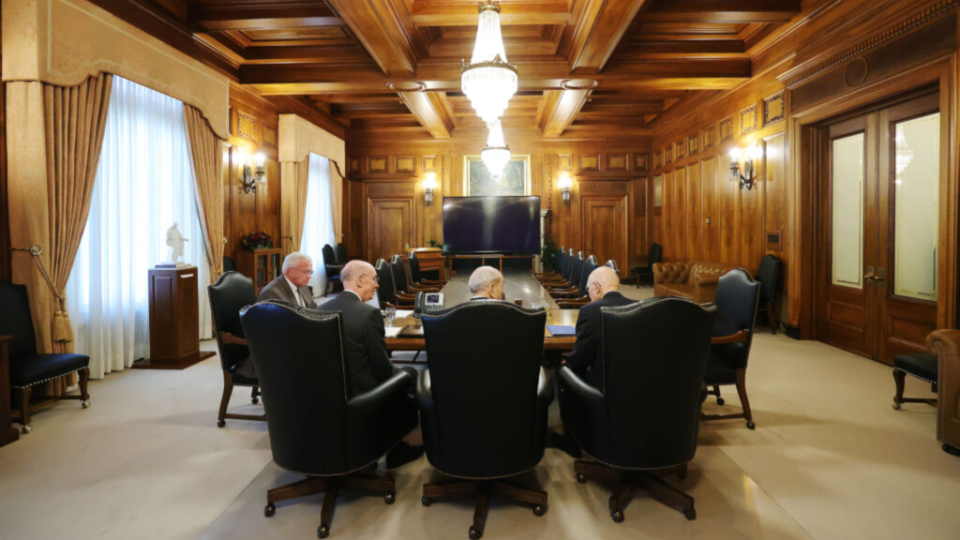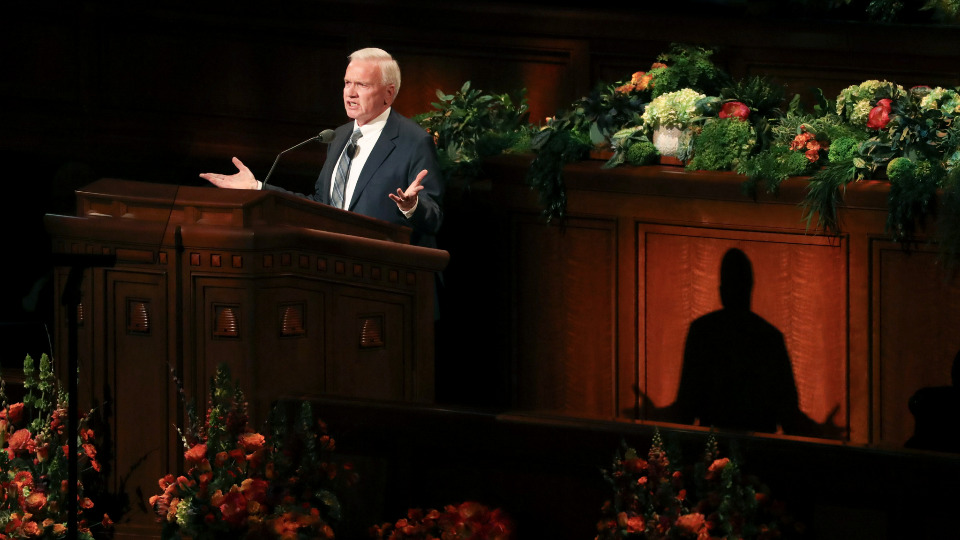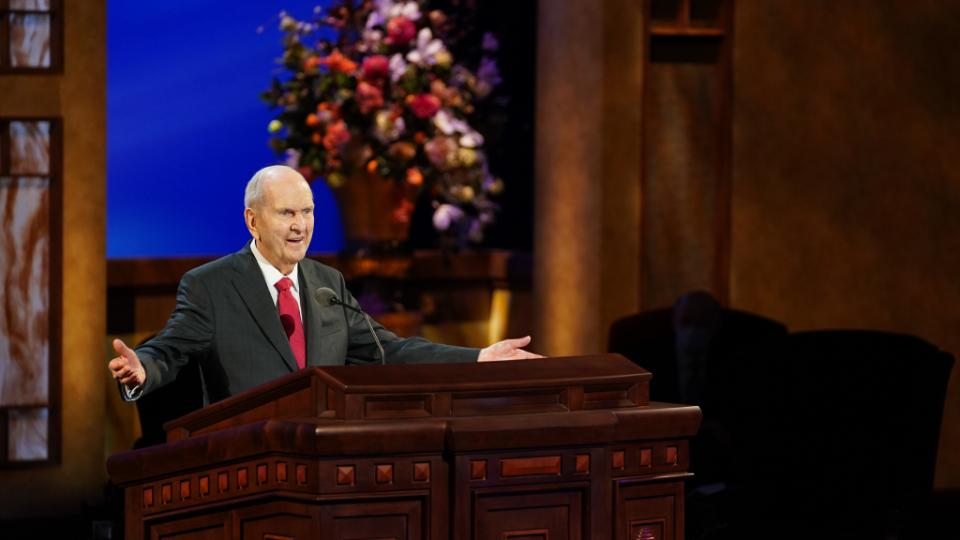
Church-Councils
President Russell M. Nelson of The Church of Jesus Christ of Latter-day Saints and his counselors, President Dallin H. Oaks, first counselor, and President Henry B. Eyring, second counselor, attend a First Presidency meeting, held daily Tuesday through Friday, at the Church Administration Building in Salt Lake City on Wednesday, June 16, 2021. The Church Administration Building was constructed between 1913 and 1917. Photo by Jeffrey D. Allred, courtesy of Church News.Copyright 2021 Deseret News Publishing Company.This story appears here courtesy of TheChurchNews.com. It is not for use by other media.
By Sarah Jane Weaver, Church News
General conferences of The Church of Jesus Christ of Latter-day Saints are truly “heaven-directed,” said Elder Brook P. Hales, a General Authority Seventy.
“The Lord is the executive producer,” he said. “This is His event. He wants it to happen. He helps it happen.”
Through his work in Office of the First Presidency, Elder Hales has been involved in general conference preparations since 1997.
During that time he has learned one important thing about planning and organizing the mammoth event: “This is the opportunity for the Lord to speak to His people, unique in every way possible,” he said. “I can trust God and the Savior completely.”
If members will prepare for the event, he added, “we will come away better people than we were.”
Elder Hales, secretary to the First Presidency, likes to remember that holding general conference is scriptural. The Lord instructed the Prophet Joseph Smith, as recorded in Doctrine and Covenants 20, that “several elders composing this church of Christ are to meet in conference … from time to time.”
About two months after the organization of The Church of Jesus Christ of Latter-day Saints, the first conference was held on June 9, 1830; 27 people attended. Of the event, the Prophet Joseph said: “Much exhortation and instruction was given and the Holy Ghost was poured out upon us in a miraculous manner. Many of our numbers prophesied, while the heavens were open to others.”

producing conference
Elder Brook P. Hales, a General Authority Seventy, speaks in the Conference Center in Salt Lake City during the morning session of the 189th Annual General Conference of The Church of Jesus Christ of Latter-day Saints on Saturday, April 6, 2019. Photo by Steve Griffin, courtesy of Church News.Copyright 2021 Deseret News Publishing Company.
In stark contrast to the 27 people participating in the Church’s first general conference, millions tune in today. An extremely small number of Latter-day Saints participate in conference from the Conference Center.
Millions view the proceedings via the Internet, on commercial television and via social media.
Producing conference requires a cadre of people, he said. “It goes way beyond coming in and unlocking the doors and turning on the lights.”
Facilities employees are in charge of parking, cleaning, preparation and setting up — a task that takes 38,180 estimated hours. Publishing Services employees, who translate and publish the talks, spend an additional 53,000 hours. Conference is translated into 98 languages.
In addition, grounds workers ensure Temple Square looks its best. Salt Lake Police Department helps with traffic control. Church security ensures all the patrons who enter the Conference Center are safe. Choir members and organists prepare the music.
“You have all these dedicated, wonderful people who are volunteering and working to bring conference to the one,” he said. “It’s a mammoth undertaking that almost brings you to tears when you think about how people are just so dedicated and consecrated to bring to pass this very important and scriptural event that blesses the lives of members and anyone else who cares to listen or read or view.”
The process humbles Elder Hales “to my toes.”
“These people are all working, they’re all dedicated, and that is so humbling to me that they are willing to do this for members of the Church.”

Apr-2021-Priesthood-Cody-Bell-President-Nelson
President Russell M. Nelson reflects back on what has been learned the last two years since the last priesthood session of general conference was held in 2019. He speaks from the Conference Center Theater on Temple Square in Salt Lake City, Utah, on Saturday, April 3, 2021. 2021 by Intellectual Reserve, Inc. All rights reserved.
Elder Hales said the conference planning process begins by the Office of the First Presidency in late October and April — shortly after the previous conference ends.
Each conference session needs to be exactly one hour, 58 minutes and 56 seconds. This includes prelude, talks, prayers, hymns and conducting notes. A computer program helps those making the plans figure out how many speaking slots they have to fill. The First Presidency gets a little more time than the Quorum of the Twelve Apostles, who get a little more time than the rest of the speakers. The First Presidency and Quorum of the Twelve Apostles speak at every conference. Other general Church leaders speak on a rotating basis. Musical numbers are calculated down to the second.
When the schedule is complete the First Presidency reviews it and takes it to the temple meeting where it is reviewed and approved by the First Presidency and the Quorum of the Twelve Apostles. Assignment letters go after that, usually in early November and early May.
Those assigned to speak go to the “teleprompter rehearsal room” to practice their addresses, where they get a feel for what it might be like in the Conference Center. Speakers are encouraged to write their talks a little short, because when they see the audience and hear the feedback they slow down, said Elder Hales.
Those who are assigned to pray are told they have one minute. “A prayer doesn’t need to be long, and so most people are really aware, cognizant that they should take perhaps less time than in another setting.”
The beauty of it is general conference speaking topics are rarely assigned, Elder Hales explained. Members of the First Presidency and Quorum of the Twelve Apostles, who speak at every conference, begin working on the next talk for one conference in the weeks after the previous conference ends.
As a result, numerous topics are covered during general conference, allowing a wide range of listeners to receive answers to their questions. “We go to a great deal of work and effort to prepare for conference,” he said.
As a result, Latter-day Saints can have a firm and complete testimony that they can find answers to their questions and answers to their situations through general conference if they prepare themselves and invest the time and effort to either watch, listen or study the conferences. “It doesn’t matter, really, how we do that, as long as we somehow come to the table and feast on general conference in the way that is most convenient and best for us according to our own learning style, and the time and the opportunities we have,” he said.
That doesn’t mean everything goes as planned.
Take, for example, a moment in October of 2007 general conference when Elder Joseph B. Wirthlin of the Quorum of the Twelve Apostles locked his knees while giving his address and grew increasingly weak. As he began to shake, Elder Hales and security looked at each other to determine what to do. But before they could act, then-Elder Russell M. Nelson of the Quorum of the Twelve Apostles just stepped forward and steadied him.
“That was just very tender to see President Nelson help his fellow Apostle and friend and brother for many, many years, get through his talk,” said Elder Hales.
After planning and executing so many general conferences, two conference moments stand out for Elder Hales — when President Thomas S. Monson and President Russell M. Nelson were sustained as Church presidents. In both cases he knew what was going to be said because he read the words prepared for the sustainings in advance.
“In both cases, I was sitting there, and even though I knew the words that were going to be spoken, I had a tangible impression that the mantle of Prophet had fallen on both of those men. It was really quite remarkable that I felt that. I knew what was going to happen. I knew the words. But to have that spiritual manifestation that these two men, each in their own time, had been called by the Lord and were being sustained by the membership of the Church to become President of the Church, was truly a remarkable experience that I did not expect.”
Copyright 2021 Deseret News Publishing Company

